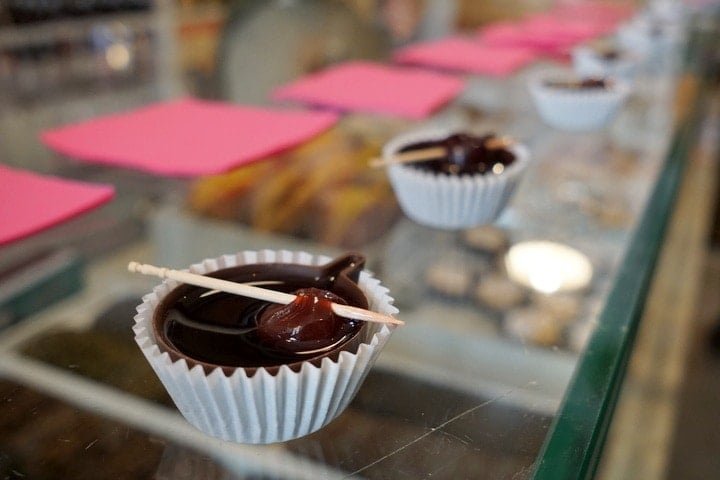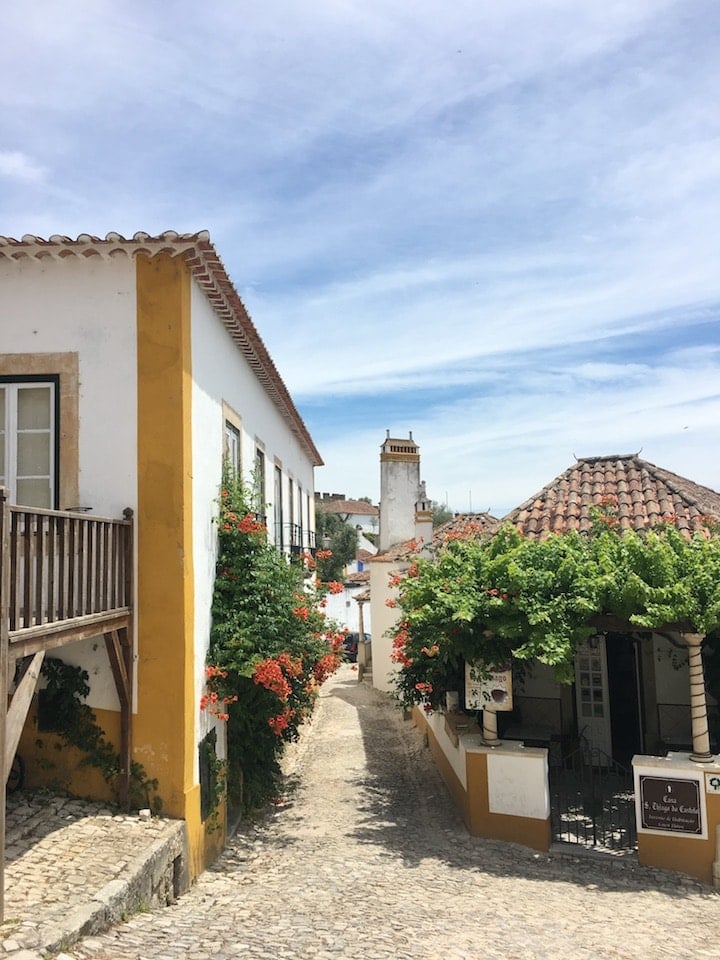
[ad_1]
Everywhere you go in Portugal, you’ll find a certain iconic local liqueur. Your trip isn’t complete until you’ve tried it—but what is ginjinha, and why is it so special?
As a self-described ginjinha fanatic, I have a few ideas. There’s something about this drink’s simple combination of ingredients and celebratory spirit that makes it a favorite of locals and tourists alike.
The only way to truly understand is to try it, but here’s my attempt at the next best thing: to explain why I’m totally head over heels in love with this classic Portuguese liqueur.
What Is Ginjinha?
Ginjinha is a Portuguese liqueur made from sour cherries. It’s dark red in color and is served in small shot glasses or edible chocolate cups. It can be found at roadside stands and restaurants from Porto to the Algarve and everywhere in between, and is a must-try food for any visitor to Portugal.
The Difference Between Ginja & Ginjinha
If you pay close attention, you’ll notice that these two words are often used interchangeably. So what’s the deal? Are they actually different?
Technically, ginja is the Portuguese word for the sour cherry itself, whereas ginjinha is the alcohol made from this fruit. However, you can refer to the drink as either one.
In fact, many brands market it as ginja, including the famous Ginja de Óbidos. I often switch back and forth between the two terms, and it’s never caused any confusion.
Why Is Ginjinha So Good?
Most people either love or hate ginjinha as soon as they try it. I fall firmly into the first camp, and I’ll tell you why.
Ginjinha has an unmistakeable cherry flavor that hits you full on. It’s simultaneously sweet and strong, which is my favorite kind of alcohol; it’s why I love Spanish vermouth, Pedro Ximénez, and port wine as well.
I’m a sucker for something that tastes good and packs a punch, and ginjinha does exactly that. In other words, it’s like a liquid dessert that gets you tipsy… what’s not to love?
How to Drink Ginjinha
First things first: it’s not a shot. Just because it’s served in a shot glass, that doesn’t mean you need to toss it back like tequila. It’s best to sip it slowly, savor the taste, and enjoy it.
Then there’s the question of the cup itself. Many places have started serving ginjinha in small cups made of dark chocolate, which you can devour right after you take the last sip.
This isn’t the traditional way to drink it, but there’s no denying that it’s delicious. The chocolate perfectly complements the cherry flavor, and turns it from a simple drink into a whole experience.

Finally, the big question: com ou sem elas? Literally, this means “with or without them?” It refers to the sour cherries themselves, which can usually be found bobbing in the bottle. For the full experience, always go for com elas (with them). The cherries are soft and strikingly sour—just watch out for the pit!
Join us on a food tour in Lisbon to try some of the city’s most authentic ginjinha!
Why Ginjinha Has a Special Place in My Heart
I first tried ginjinha at a local festival in Ferrel (a small village in central Portugal), where I bought it from a street vendor. I was immediately hooked. Since then I’ve had it in Lisbon, on the streets of Óbidos, at countless restaurants, and even straight from the bottle.

What do all these experiences have in common? In every case, ginjinha adds a festive flair and a special treat to any occasion. It’s the perfect drink for a toast, to celebrate, or to end a delicious meal.
It also makes for a great Portuguese souvenir or gift. I’ve bought many bottles (big and small) for people I care about, to say thank you or show that I’m thinking about them.
An Authentic Taste of Portugal
Above all, the best thing about ginjinha is that it so clearly and lovingly represents its place of origin. It’s an undeniable symbol of Portuguese culture, and a local product that brings together people of every origin and age (18 and over, of course).
I love ginjinha not just because it tastes good and only costs about €1 per glass, but because it’s always connected to good memories. It’s something to be shared and savored, just like all the best eating—and drinking—experiences.
Ginjinha FAQs
Ginjinha is made by infusing distilled alcohol (aguardente) with sour cherries (ginjas) and flavoring it with sugar and cinnamon. Traditionally, the cherries are left to soak in the liquor for several months before it’s ready to drink.
The simple answer is Portugal, and the village of Óbidos is particularly famous for its locally made ginjinha. But as the story goes, the drink was originally invented by a Galician friar at the Igreja de Santo António in Lisbon.
Ginjinha has an ABV (alcohol by volume) of about 18–24%, meaning it’s stronger than wine but weaker than spirits like rum or vodka. It’s similar in strength to fortified wines like port and sherry.
You can find ginjinha all over Lisbon, but the best places to try it are often the most traditional. I especially love Ginjinha Sem Rival and A Ginjinha, both of which are right downtown near Rossio.
Heading to Portugal? Don’t miss our 5* Lisbon food and walking tours! Looking for Spanish recipes? Download our free ingredients guide and get a weekly recipe sent directly to your inbox.
[ad_2]
Source link